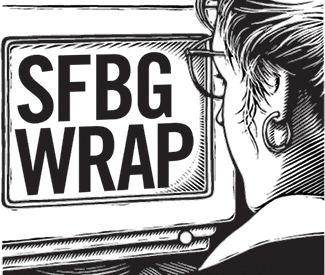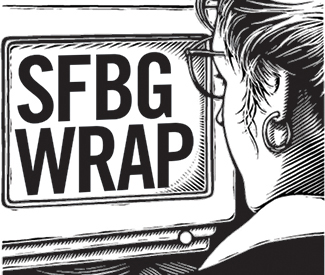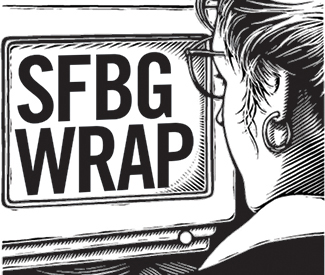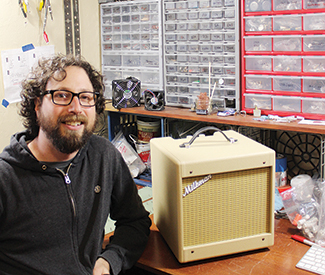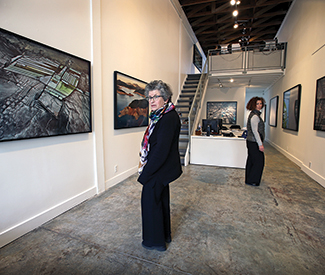art@sfbg.com
Geary Boulevard runs almost the entire length of San Francisco, beginning in the middle of the Financial District, at the historic Lotta’s Fountain. Along the first few blocks of one of the city’s longest streets — amid a bustling community of corporate offices, luxury boutiques, and specialty coffee houses — the city oldest established art galleries have thrived. But that’s changing.
Three art galleries used to share the second floor of 77 Geary. Now, it is headquarters of a technology firm. Rena Bransten Gallery, George Krevsky Gallery, and Accession Gallery were sent eviction notices in January, forced out by the expansion of the building’s fourth floor tenants, MuleSoft. The software and consulting company offered to pay double the art galleries’ rent. When a counter-offer was too costly for the gallery owners, the art spaces were forced to relocate or close indefinitely.
News of the eviction of these three galleries broke in January, inciting an outcry about affordability and displacement caused by the tech industry, an all-too-common San Francisco narrative these days. These galleries were forced out of a space they had occupied for decades, a space where they had cultivated a community of artists and art-lovers alike, a place where the two could easily connect.
The affordability and displacement crisis is not news to San Francisco. With stores closing and opening daily and eviction notices sent out left and right, the fodder for concern about the changing face of the city is inexhaustible.
>>READ OUR FULL CAREERS AND ED ISSUE: HOW TO SURVIVE AS AN ARTIST HERE
What’s worrisome about the 77 Geary gallery evictions is not so much the evictions themselves, but rather what it means for the future of art in San Francisco. Galleries serve as a gathering space for artists to sell art and for the community to appreciate it. Without the walls of a gallery, where will artists sell their work? How do we continue the thriving community of artists and art lovers? And most importantly, what will become of the art world as we move towards an increasingly digital world?
GALLERIES AS INCUBATORS
Public art museums, or art galleries, have been around since the late 1700s. For centuries, they’ve functioned as hubs of culture where art is not simply sold, but appreciated. Over time, commercialization has plagued the art world, artists and art galleries alike have had to focus on sales over building a culture and a community. In the past few years, gallerists have seen the landscape of the art world shift so dramatically that they’ve been unable to keep up.
“Local galleries are under assault,” Trish Bransten, director of Rena Bransten Gallery, tells the Guardian. This 27-year-old gallery on Geary was run by a mother and daughter team. They recently relocated to 1639 Market St, a townhouse-like space that recently the public. The white walls stretch up two floors, with a loft in the back. There’s potential here, Trish says, despite the 1,100- square-foot gallery being a quarter the size of its previous location. The five-woman staff sits in a circle, comfortably discussing the changing art scene over martinis.
What they describe as an “assault” comes from different angles. The Mulesoft eviction was an easy target for pinning the blame on technology companies, but the problem lies deeper that. It’s been 20 years since the World Wide Web was introduced to the public and some industries are seeing consequences only now.
The digitization of our lives has had a profound effect on the art world. Similar to when the Internet upturned the journalism and publishing industries, the art industry is struggling to move forward in the digital world — all these content providers forced to find new ways to reach their audiences.
Heather Marx and Steve Zavattero have been gallery owners for 12 years, until last year. Marx & Zavattero Gallery was part of the 77 Geary galleries until they decided to close six months before the formal eviction. It became clear to the couple that the old model of art galleries was changing. The art world was shifting from under their feet and they felt that they could not move forward with the old model of selling art.
“We were straddling the old school and the new school,” says Zavattero, who was part of the first tech boom in the 1990s before joining his wife’s gallery. He remembers Marx & Zavattero Gallery as a gathering place for wonderful visuals, great ideas, and stimulating conversation. “Maybe that’s just an archaic notion at this point with the world speeding up this much,” he says. “I think in San Francisco it’s happening at such a rapid acute pace that it’s ominous in a sense.”
Gallerists traditionally find artists for an exhibition and then support them throughout their career. Putting on an artist exhibition takes weeks of preparation. It’s a creative process where the gallerists work in tandem with the artist to create a story about the artwork. Most exhibitions are open to the public free of cost. The purpose of an art exhibition isn’t just to sell paintings, photographs, or sculptures. Galleries function in a similar way to museums. They encourage the public’s exposure to art.
“There was a real energy put around a show and certainly we had to sell because you had to stay in business and it wasn’t so market-driven,” remembers Marx, who has an advanced degree in art history but at times felt like she needed an MBA. “It was scary. Now, you can’t keep up unless you’re going to a fair at least every month. The art fairs have proliferated like wildfire and it’s really hard for a small business in its awkward teenage years to keep up.”
Art fairs commonly take place over the course of several days, where artists and art dealers show and sell their work. They can range from local street gatherings to gargantuan conventions that take over cities, like ArtBasel in Miami. Many galleries see a rise in exposure and sales from art fairs, but these shows can prove costly. From shipping costs to plane tickets, the cost often doesn’t outweigh the sales for mid-tier galleries.
The mid-tier galleries have been hit harder than new galleries and old institutions. Veteran galleries that have been in business for over 30 years, like Fraenkel Gallery and Robert Koch Gallery, have the cachet of brand and artist recognition. On the other end, new galleries are successful based on their novelty and trendiness.
Ever Gold Gallery is located in the Tenderloin and offers experimental exhibitions based on bridging old and the new art concepts. Ever Gold, dubbed the “art pushers of the Tenderloin,” put together an exhibition called “Ever Wash” that turned the gallery into a minimalist Laundromat where visitors could do their laundry for free. The edgy location offers room to experiment with cutting-edge notions like public participation and DIY exhibitions.
“You’re not quite the young hip gallery, you’re not the blue chip gallery, where are you?” asks Jenny Baie, director of Rena Bransten. Unlike Marx & Zavattero who decided not relocate to a smaller space because they felt it to be unfair to their artists, Rena Bransten is going back to its roots.
The women joke about becoming a new hip gallery because of the storefront location in an up-and-coming neighborhood. They’re excited about the prospect of building a new community. The gallery’s building is connected to artist studios, a welcome surprise.
“I didn’t even know there were artist studios left,” Trish Bransten says, only half-jokingly. “I thought they were all in Oakland.”
NEXT PHASE
Steve Zavaretto describes the art scene as an ecosystem, a delicate community of galleries, artists, and art lovers that rely on each other. With the displacement of artists and art studios from the city, where do art galleries find content? With the rise of the Internet and art fairs, can galleries really dedicate themselves to their own artist exhibitions? Where do art collectors and curators find talent if galleries keep closing?
“Having space is a luxury and ever since the Internet and the accessibility of images through the Internet, we are left constrained by having to show people things in our space,” says Catharine Clark, the owner of her eponymous gallery in Potrero Flats, an emerging hot spot in the art scene.
Clark moved her gallery out of SoMa when the San Francisco Museum of Modern Art began remodeling. The construction was going to be disruptive to the business, she says. “But we’ve certainly done business with people who have never even seen the space so one could ask questions about what is the value of space if it doesn’t contribute to — and in fact actually takes away from — the ability to be open to the rest of the world.”
The millennials expect everything to be available online. If they want to buy an Alexander McQueen dress without even trying it on, they can use Farfetch. They get their news, buy groceries, and send birthday presents online. There is undoubtedly an untapped market of art lovers who would like to purchase original art online.
A gallery artist exhibition used to be the most coveted means of exposure for artists, but the walls of a gallery seem to restrict exposure in the present day. The space a gallery is constricted compared to the limitless Internet, although many artists are reluctant to go digital because their art isn’t easily translatable into megabytes. Photographs are the easiest to convert onto screens; sculptures are the most difficult.
Jeremy Sutton is an artist who relies heavily on technology and innovation. Based in Potrero Flats, in a building comprised of artists studios, Sutton creates art on digital tablets and canvas. The charismatic painter often combines digital and physical paint. “I’m not trying to paint stuff that specifically looks digital,” he says with a smile in the comfort of his studio. “I’m trying to create artwork that evokes and speaks and communicates as an artwork and as a painting.”
Sutton’s work pays off in live action painting events. He has worked with the de Young Museum, Cirque du Soleil, and various corporate events. During the de Young events, Sutton will portray famous painters such as Henri Matisse, Edgar Degas, Pablo Picasso, and Vincent Van Gogh and create traditional and digital artwork during a live performance.
This British artist has built a strong online presence, creating a brand behind his name. While a lot of his work is digital, his most sublime pieces are better viewed in person than on a screen. He currently has an exhibit at Embarcadero Four and is working on a commission piece, yet he rarely gets business through art on the wall.
Breaking down the costly brick and mortar walls, the independent consulting business model has become popular with former gallerists. Heather Marx is launching Heather Marx Art Advisory, a consulting business based on private and corporate advising, curatorial projects, and artist collaborations.
During the 2008 financial collapse, the art industry suffered tremendously. Americans for the Arts’ 2013 National Arts Index, a score of the health and vitality of the arts in the country, increased progressively between 2003 and 2007. The two-year Great Recession showed a drop far exceeding the five years before it. The art industry is still struggling, with 2011 marking the lowest index score of the 21st century.
“We’re hearing from our colleagues, art dealers and artists in New York and Los Angeles, they’re starting to talk about what’s happening in San Francisco,” Marx says. “It’s on the topic of conversation all across the country really, within the art world. I think finally with Rena [Bransten] closing — she was one of the biggest galleries in San Francisco history and a real anchor — for her to move out and reinvent to find a space, that sort of woke everybody up.”
But the National Art Index found that arts engagement remains prosperous. Art museum attendance has been steady, but the way the public consumes art is expanding and shifting. The study found that the market is moving towards personally curated engagement, which can be seen in San Francisco.
The former George Krevsky Gallery is reinventing itself to become George Krevsky Fine Arts Services. The new business model will operate by appointment only and “will be providing art advisory services in collection management and interior design, conservation, archival framing, shipping and handling, and appraisals,” according to the website.
Adler&Co, one of the remaining galleries at 77 Geary, offers consulting services as well. The National Arts Index shows an ever-present demand for art that is undergoing a transformation in how the public chooses to participate in the arts.
CULTURAL SHIFT
When the technology industry brings in the big bucks, other industries are forced to keep up with innovation. Almost every coffee shop, retail store, and restaurant has a Yelp listing, Facebook page, and Twitter handle. Many art galleries are present on Yelp, but the art world as a whole is lacking an online presence.
“Technological advances are driving seismic shift in audience involvement and participation across all art forms,” Robert L. Lynch, president and CEO of Americans for the Arts, explained in the 2013 National Arts Index report. “Arts organizations that fully understand how to properly use these tools have a much better chance of sustaining their current audience while simultaneously attracting new patrons.”
To the dismay of many art galleries, the delivery model for the arts is going digital. Digital downloads have replaced music CD sales. Kindles and Nooks have replaced books. While the art industry is several years behind, savvy entrepreneurs are just now seeking to tap into the art market through technology.
Catherine Cu is the founder of EnzoArt, a new startup e-commerce website that brings together artists and consumers. Similar to the traditional model of art galleries, the company will provide an online representation for artists.
“I think a lot of young people may be interested in having more choices than what galleries have to offer,” Cu tells us. She draws the parallel to online shopping. “Online, we have a wealth of options — nearly infinite product options and the ability to arm ourselves with information before we make a purchase. The gallery model is a little different. There aren’t as many choices and there’s not as much transparency. Younger folks aren’t drawn to that.”
Cu intends to recreate the personal experience of art online. She envisions a model with an online marketplace similar to Airbnb, connecting artists with art buyers. The human aspect is essential to art purchasing, but instead of it being through a gallery, it will be directly between the artist and the consumer.
“It’s not just about having a piece of art to hang on the wall, which can feel impersonal and commoditized” Cu says. “It’s about connecting the buyer and the artist so that the buyer has a more meaningful experience with the piece.”
Letting people see the artist’s inspiration and process is the key to bringing online art to life, Cu maintains. Otherwise, she can create her own watercolor painting on her phone or order Van Gogh prints online. “Personally, what would motivate me to buy original art and pay the associated premium is having rich narratives behind the art,” she says.
The Rena Bransten Gallery staff agree that the personal connection is necessary to selling art. “So much of the gallery business is personality,” says Rena Bransten. Through exhibitions, the gallery gives a voice to emerging artists. They’ve seen the online model work for known artists — like photographer Dawoud Bey, a deaf artist who relies hugely on the web — but lesser well-known artists get lost in the Internet abyss.
“There’s a trend toward branding, the Web actually encourages it,” explains Trish Bransten. “Branding is really hard. Everybody wants a Warhol, even a mediocre one.”
Marx & Zavattero found it particularly difficult to keep supporting artists that they felt deserved attention when the public was looking for the next new star.
“It’s always hard to lose an artist. It’s like losing a great employee. You want to keep them happy,” Zavattero says. ” But sometimes things change, the world changes.”
The cultural shift in the demand for art has upended the art industry. With uncertainty about the future, comes different opinions about its transition. The conflict between the old model of art consumption and the emerging new model has created a seismic rift in the art community. Artists have been displaced, galleries forced to shut their doors. Nobody feels supported. The ecosystem is crumbling.
In the Financial District, where Geary Boulevard begins, the iron Lotta’s Fountain served as a meeting point during the 1906 earthquake. Today, it’s a symbol of the city’s resilience.
“We were part of the landscape, but the terrain shifted so radically,” remembers Zavattero. Several art galleries remain amid the commercial storefronts. Gallery Paule Anglin sits above Factory Outlet boasting 3XL apparel and Ho Ho Snack Shop. Art and fashion mingle with an Alexander McQueen boutique, as well as luxury retailers like Nespresso. Above the high-end espresso brand, MuleSoft has now moved into the second floor, taking over the space where the heart of a thriving art ecosystem once beat.
There are always waves in San Francisco. Change is the only constant, but the challenge is to preserve our unique urban culture, from the artists to the activists. Our civic duty is to find a way to preserve the ephemeral zeitgeist of San Francisco through innovation — or sometimes in spite of the innovations that are remaking the city.
Heather Marx and Steve Zavattero lament over threats to the wealth of diversity in the city. Trish Bransten feels a loss of counterculture that once made the city engaging and interesting. There’s a lot of heat coming down on the tech industry, but the anger against it can be a distraction. It’s really up to us to curate this city.
“My big concern for San Francisco — I don’t think it’s a tech versus art thing,” says Catharine Clark, who once lost a rent bid to a kitchen appliance store. “It’s how can we define what type of community we want to live, work, write in and help that be realized. I actually think it’s a civic problem.”





